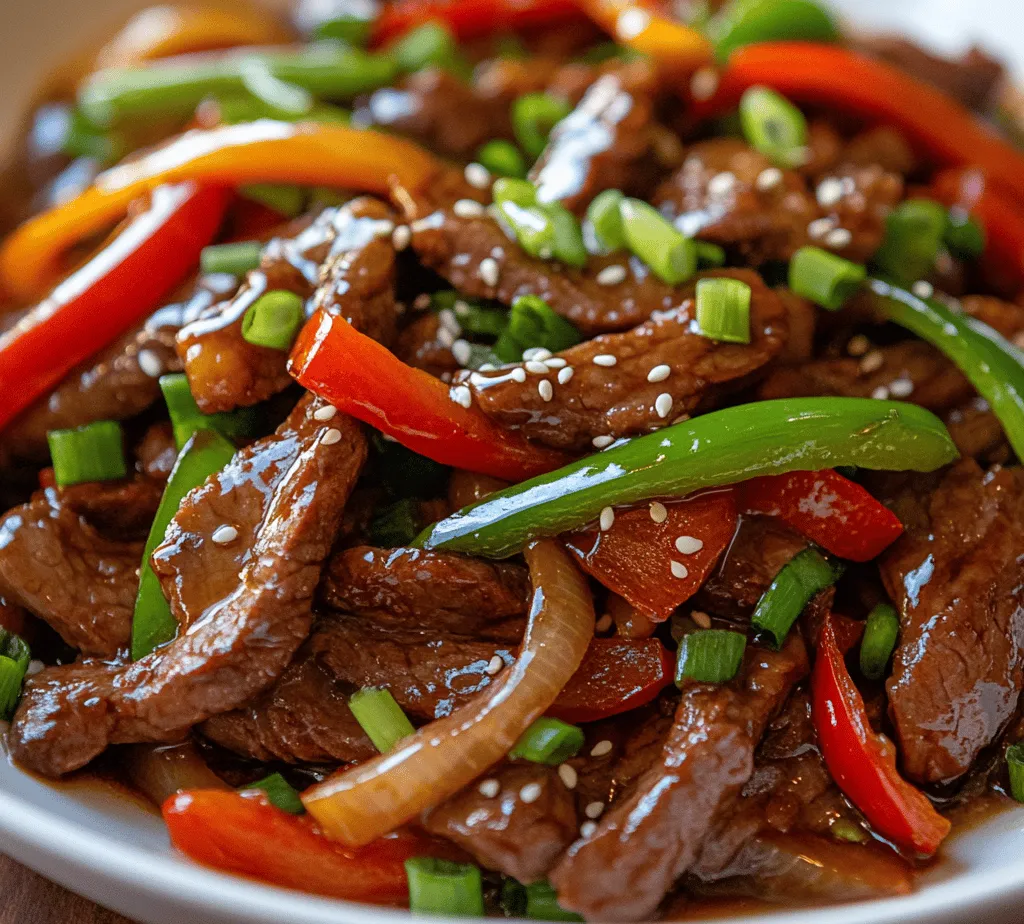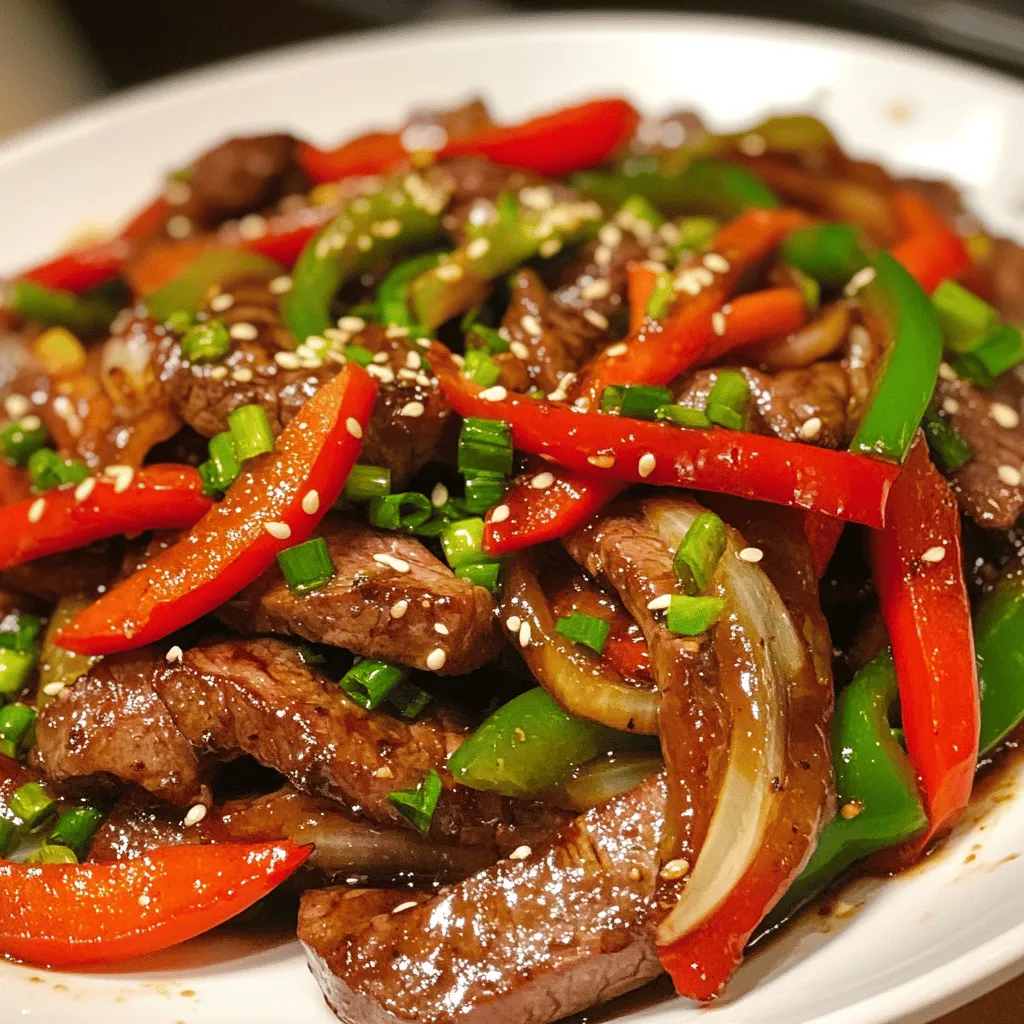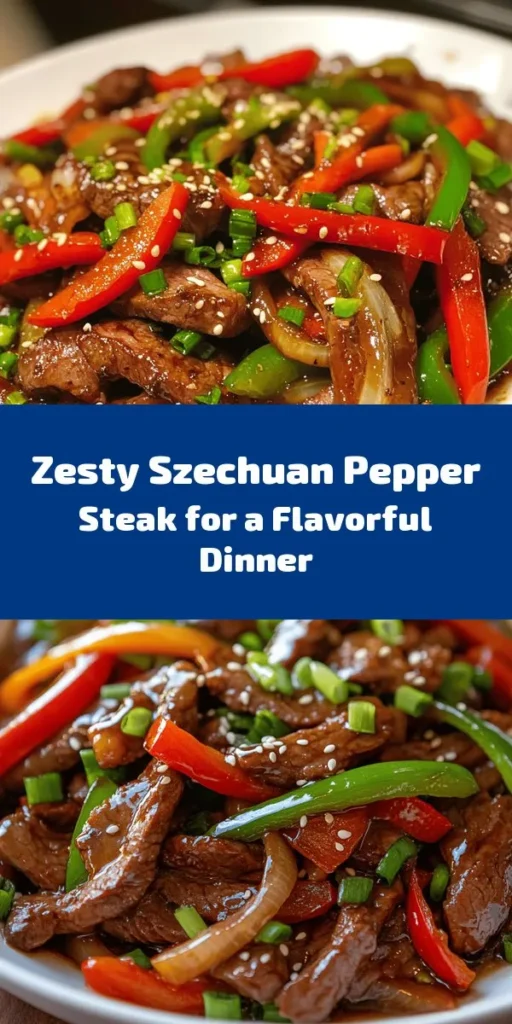Introduction
Embarking on a culinary adventure can be as simple as preparing a dish filled with bold flavors and tantalizing aromas. One such dish that truly encapsulates the vibrant essence of Chinese cuisine is the Spicy Szechuan Pepper Steak. This dish is not just a meal; it is a delightful experience that transports you to the heart of Szechuan, a region renowned for its distinctive flavors and culinary traditions. In this article, we will delve into the rich history of Szechuan cooking, explore the significance of its unique ingredients, particularly the mesmerizing Szechuan peppercorns, and provide a comprehensive guide to making this mouthwatering dish.
Exploring Szechuan Cuisine
Understanding the essence of Szechuan cuisine is essential to appreciate the art of preparing Spicy Szechuan Pepper Steak. Szechuan food, originating from the southwestern province of China, is celebrated for its bold and diverse flavors, which often include a potent mix of spicy, sour, sweet, and savory notes. This vibrant culinary style has its roots in the local geography, climate, and culture, which have all influenced the ingredients and cooking techniques employed in the region.
Brief History and Origins of Szechuan Food
The history of Szechuan cuisine can be traced back over two thousand years, characterized by its unique blend of indigenous ingredients and influences from other regions due to trade and migration. Originally, the cuisine was simple and rustic, relying heavily on preserved foods. However, as the region developed, the introduction of spices and new cooking methods led to the establishment of a rich culinary tradition. By the time of the Ming and Qing dynasties, Szechuan cooking had gained prominence across China, celebrated for its innovative use of spices and flavors.
Key Characteristics: Bold Flavors, Spice, and Aroma
What sets Szechuan cuisine apart from other Chinese culinary styles is its boldness. The combination of intense flavors results from the use of various ingredients, including garlic, ginger, and a variety of chili peppers. Szechuan dishes are often characterized by their heat, yet this heat is balanced with sweetness and acidity, creating a harmonious dish that excites the palate. The cuisine is also known for its aromatic quality, often enhanced by the use of fresh herbs and spices that tantalize the senses.
The Role of Szechuan Peppercorns in Flavor Profiles
Central to the flavor profile of many Szechuan dishes is the enigmatic Szechuan peppercorn. Unlike traditional black pepper, Szechuan peppercorns are the husks of the prickly ash tree and deliver a unique flavor that is both citrusy and woody. However, their most distinct characteristic is the numbing sensation they impart on the palate, known as “mala.” This sensation creates a captivating contrast to the heat from chili peppers, making the dining experience truly unforgettable. In the Spicy Szechuan Pepper Steak, these peppercorns elevate the dish, providing depth and complexity that is synonymous with authentic Szechuan cuisine.
The Star Ingredient: Szechuan Peppercorns
What Are Szechuan Peppercorns?
Szechuan peppercorns are a key ingredient in Chinese cooking, particularly in Szechuan cuisine. They are not true peppercorns but rather the dried husks of the seeds from the prickly ash tree, which is native to the Szechuan province. These peppercorns are typically reddish-brown in color and are known for their complex flavor profile that includes a hint of citrus.
Distinctive Taste and Numbing Sensation
The taste of Szechuan peppercorns can be described as warm, slightly sweet, and lemony, with an unmistakable numbing effect on the tongue. This unique combination adds a layer of complexity to dishes, balancing the heat from other spices and allowing the other flavors to shine. When used in moderation, Szechuan peppercorns can enhance the overall flavor of a dish, making it an essential ingredient in Spicy Szechuan Pepper Steak.
Health Benefits and Culinary Uses
Beyond their culinary appeal, Szechuan peppercorns also offer several health benefits. They are believed to aid digestion, reduce inflammation, and even possess antibacterial properties. Additionally, their aromatic qualities make them a versatile ingredient in various dishes, from stir-fries to marinades. In Spicy Szechuan Pepper Steak, these peppercorns not only provide flavor but also contribute to the dish’s overall health benefits, making it a delicious and nutritious choice.
Preparing for the Recipe: Essential Ingredients
To create an authentic and flavorful Spicy Szechuan Pepper Steak, it is crucial to gather the right ingredients. Each component plays a significant role in achieving the desired taste and texture of the dish.
Flank Steak: Choosing the Right Cut
The primary protein in this recipe is flank steak, which is known for its rich flavor and tenderness when cooked correctly. When selecting flank steak, look for cuts that are bright red with a good amount of marbling. The marbling ensures that the steak remains juicy and flavorful during cooking. Always slice the steak against the grain to ensure tenderness in each bite.
The Importance of Soy Sauce and Oyster Sauce
Soy sauce and oyster sauce are two essential condiments that contribute to the umami flavor profile of Spicy Szechuan Pepper Steak. Soy sauce adds depth and saltiness, while oyster sauce brings a hint of sweetness and complexity. When combined, these sauces create a harmonious balance that enhances the overall taste of the dish. Look for high-quality soy sauce and oyster sauce to ensure the best flavor.
Role of Cornstarch in Marinating
Cornstarch is a crucial ingredient in the marination process of the steak. It not only helps to tenderize the meat but also creates a velvety texture when cooked. When the cornstarch is mixed with the soy sauce and other marinade ingredients, it forms a coating that allows the steak to retain moisture and flavor during the cooking process.
Fresh Vegetables: Bell Peppers, Onions, Garlic, and Ginger
Fresh vegetables play a significant role in adding color, texture, and nutrition to Spicy Szechuan Pepper Steak. Bell peppers provide sweetness and crunch, while onions add a subtle sharpness. Garlic and ginger are aromatics that infuse the dish with their distinct flavors. Using a combination of these vegetables will enhance the overall appeal and taste of the final dish.
Understanding Chili Paste and Its Heat Levels
Chili paste is a key ingredient that brings the heat to Spicy Szechuan Pepper Steak. There are various types of chili pastes available, ranging from mild to extremely spicy. When selecting a chili paste, it is important to consider your heat tolerance and the desired spiciness of the dish. A well-balanced chili paste will not only provide heat but also add depth and richness to the sauce.
Step-by-Step Guide to Making Spicy Szechuan Pepper Steak
Now that we have explored the essential ingredients and their roles in creating a delicious Spicy Szechuan Pepper Steak, it’s time to delve into the step-by-step guide for making this dish. Following these instructions will ensure that you achieve the perfect balance of flavors and textures.
1. Marinating the Steak: Begin by slicing the flank steak against the grain into thin strips. In a mixing bowl, combine soy sauce, oyster sauce, and a tablespoon of cornstarch. Add the sliced steak, ensuring that each piece is evenly coated. Allow the steak to marinate for at least 30 minutes. This step is crucial, as it enhances the flavor and tenderness of the meat.
2. Preparing the Vegetables: While the steak is marinating, wash and chop the bell peppers and onions into bite-sized pieces. Mince the garlic and ginger, as these aromatics will be added to the dish later. Having everything prepped and ready will make the cooking process smoother.
3. Cooking the Steak: Heat a large skillet or wok over high heat. Add a tablespoon of oil and allow it to heat until shimmering. Carefully add the marinated steak to the hot pan in a single layer. Cook for about 2-3 minutes until the steak is browned and cooked through. Avoid overcrowding the pan; if necessary, cook the steak in batches to achieve a nice sear.
4. Adding the Aromatics: Once the steak is cooked, remove it from the pan and set it aside. In the same skillet, add a bit more oil if needed, and toss in the minced garlic and ginger. Stir-fry for about 30 seconds until fragrant, being careful not to burn them.
5. Incorporating the Vegetables: Add the chopped bell peppers and onions to the skillet. Stir-fry for 2-3 minutes until the vegetables are tender-crisp. The vibrant colors and textures will enhance the overall appeal of the dish.
6. Bringing It All Together: Return the cooked steak to the skillet and sprinkle in a tablespoon of Szechuan peppercorns and chili paste, adjusting the amount based on your preferred heat level. Toss everything together, allowing the flavors to meld for an additional minute. The final step is to ensure that the steak is well coated in the sauce, and the vegetables are evenly distributed.
With these steps, you are well on your way to creating a delicious Spicy Szechuan Pepper Steak that will impress your family and friends. In the following sections, we’ll explore tips for achieving the best results, answer common questions, and provide additional insights to enhance your cooking experience. Stay tuned for the next part of this flavorful culinary journey!

Marinating the Flank Steak: Techniques and Timing
Marinating the flank steak is a crucial step in developing the bold flavors that characterize Spicy Szechuan Pepper Steak. To achieve maximum tenderness and flavor infusion, consider the following techniques:
1. Time Matters: Ideally, marinate the steak for at least 30 minutes to 2 hours. This allows the marinade to penetrate the meat effectively, enhancing its taste and tenderness. For deeper flavor, you can even marinate it overnight in the refrigerator.
2. Marinade Composition: A typical marinade for Szechuan Pepper Steak includes soy sauce, rice vinegar, sesame oil, garlic, and Szechuan peppercorns. The acidity from the vinegar helps to tenderize the meat, while the soy sauce adds umami richness.
3. Using a Ziploc Bag: To ensure the marinade coats the steak evenly, place the flank steak in a resealable Ziploc bag along with the marinade. Seal the bag and massage it gently to distribute the marinade. This method also minimizes cleanup and allows for easy storage in the fridge.
4. Room Temperature: Before cooking, allow the marinated steak to sit at room temperature for about 15-20 minutes. This helps in even cooking and prevents the meat from becoming tough when it hits the heat.
Sautéing the Steak to Perfection: Tips for Browning
Searing the marinated flank steak is where you’ll develop delicious caramelization and depth of flavor. Here are some tips for achieving perfect browning:
1. High Heat is Key: Use a heavy-bottomed skillet or a wok over high heat. This allows for a quick sear, which locks in juices and creates a savory crust.
2. Oil Selection: Choose an oil with a high smoke point, such as canola or grapeseed oil. This ensures that the oil doesn’t burn and imparts a clean flavor to the steak.
3. Don’t Crowd the Pan: Avoid adding all the steak at once. If your skillet is crowded, the temperature will drop, resulting in steaming rather than searing. Cook in batches if necessary, allowing each piece to get a good sear.
4. Timing Matters: Sear the steak for about 3-4 minutes on each side for medium-rare, depending on the thickness. Use tongs to flip the steak instead of a fork, which can pierce the meat and release juices.
5. Resting Period: After cooking, let the steak rest for 5-10 minutes before slicing. This resting period allows the juices to redistribute, leading to a more flavorful and moist steak.
Stir-Frying Vegetables: Achieving the Perfect Texture
The vegetables in Spicy Szechuan Pepper Steak not only add color and nutrition but also balance the richness of the steak. To achieve the right texture, follow these stir-frying tips:
1. Cut Uniformly: Slice your vegetables (bell peppers, onions, and snap peas) into uniform pieces to ensure even cooking. This helps them retain their crunch and prevents some pieces from overcooking while others are underdone.
2. High Heat and Quick Cooking: Stir-fry the vegetables over high heat for 2-3 minutes. This quick cooking method keeps them vibrant and crisp.
3. Sequential Cooking: Add vegetables to the skillet in stages based on their cooking time. Start with bell peppers and onions, as they take slightly longer, then add snap peas near the end to retain their crunch.
4. Aromatics: Enhance the flavor by adding minced garlic and ginger to the skillet after the vegetables have been stirred for a minute. This will create a fragrant base that complements the steak beautifully.
Combining Flavors: Bringing It All Together in the Skillet
Once the steak and vegetables are cooked, it’s time to combine them with the remaining marinade to create a cohesive dish:
1. Deglaze the Pan: After removing the cooked steak, pour a small amount of the leftover marinade into the hot skillet. Scrape up any browned bits from the bottom of the pan; this adds flavor to your dish.
2. Return the Steak: Add the sliced steak back into the skillet along with the stir-fried vegetables. Pour in the remaining marinade and toss everything together over medium heat for about 1-2 minutes, allowing the flavors to meld.
3. Finish with Freshness: For an extra layer of flavor, toss in freshly chopped scallions and cilantro just before serving. This adds a burst of freshness that complements the spicy and savory elements of the dish.
Garnishing for Presentation: How to Elevate Your Dish
Presentation is key to any great dish, and Spicy Szechuan Pepper Steak is no exception. Here are some tips for garnishing:
1. Color Contrast: Use vibrant garnishes such as thinly sliced red chili peppers and freshly chopped cilantro. The bright colors will make the dish visually appealing.
2. Serve on a Bed of Greens: Consider serving the steak and vegetables on a bed of steamed bok choy or lettuce to add a fresh element to the dish.
3. Drizzle with Sauce: A light drizzle of sesame oil or a sprinkle of sesame seeds can enhance the appearance and add a nutty flavor.
4. Use a Wide Plate: A wide, shallow plate can help showcase the dish better than a deep bowl. Arrange the steak and vegetables artfully, and leave some space for garnishes.
Flavor Pairings and Serving Suggestions
To create a well-rounded meal, consider these flavor pairings and serving suggestions:
Enhancing Your Meal with Complementary Flavors
1. Side Dishes: Serve with light, refreshing sides like cucumber salad or pickled vegetables. These can balance the spicy notes of the steak.
2. Best Rice Options: The right rice can elevate your Szechuan meal. White rice is traditional, but brown rice adds a nuttiness, while fried rice can introduce additional flavors and textures.
3. Wine and Beverage Pairings: Pair your Spicy Szechuan Pepper Steak with a chilled Riesling or a fruity Pinot Noir. For non-alcoholic options, consider a lightly sweetened iced tea or a ginger soda to complement the spice.
Nutritional Information
Understanding the health aspects of Spicy Szechuan Pepper Steak can help you make informed choices:
1. Caloric Breakdown per Serving: A typical serving of Spicy Szechuan Pepper Steak contains around 350-450 calories, depending on portion sizes and added ingredients.
2. Nutritional Benefits: Flank steak is a lean source of protein, providing essential amino acids. The vegetables contribute dietary fiber, vitamins, and minerals, making this meal not only satisfying but also nutritious.
3. Adjusting the Recipe for Dietary Preferences: To make this dish gluten-free, substitute soy sauce with tamari. For a low-carb version, serve it over cauliflower rice instead of traditional rice.
Cultural Significance of Szechuan Pepper Steak
Spicy Szechuan Pepper Steak is more than just a meal; it carries cultural significance within Chinese cuisine:
1. Celebrating Culinary Traditions: This dish showcases the bold and complex flavors of Szechuan cooking, which is known for its use of spice and aromatics. The Szechuan peppercorn adds a unique numbing sensation that is characteristic of the region’s cuisine.
2. Festive Meals and Gatherings: Szechuan Pepper Steak is often enjoyed during festive occasions and family gatherings, symbolizing warmth, togetherness, and abundance.
3. Modern Twists: While traditional recipes remain popular, modern twists on Szechuan Pepper Steak include the use of alternative proteins or vegetarian adaptations, reflecting evolving dietary preferences and trends.
Conclusion
Spicy Szechuan Pepper Steak is not just a meal; it’s an experience that encapsulates the vibrant spirit of Szechuan cuisine. With its bold flavors and aromatic spices, this dish invites you to explore the depths of culinary artistry. By mastering this recipe, you’re not only treating your taste buds but also connecting with a rich cultural heritage that celebrates food as a form of expression. Enjoy the journey of preparing and savoring this delightful dish, and share it with those you love. Embrace the flavors, appreciate the cooking techniques, and revel in the joy of creating a meal that brings people together.



